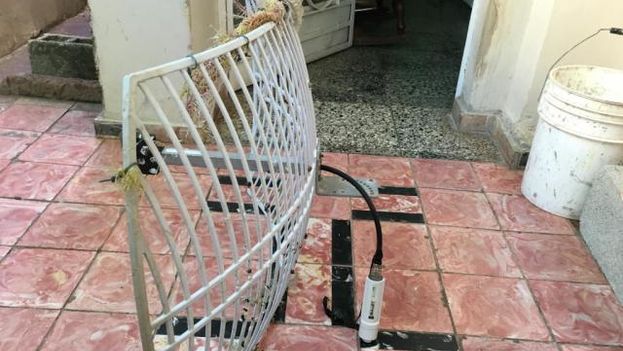
![]() 14ymedio, Marcelo Hernandez, Havana, 4 January 2017 – All one has to do is turn on a small wifi antenna and aim it toward the balcony for a computer screen to show the long list of wireless networks that link the entire neighborhood. Invisible threads that connect hundreds of users. The material support of this network are the NanoStations, Bullets, Rockets, Routers and Yagi antennas, the most coveted technological objects on the island.
14ymedio, Marcelo Hernandez, Havana, 4 January 2017 – All one has to do is turn on a small wifi antenna and aim it toward the balcony for a computer screen to show the long list of wireless networks that link the entire neighborhood. Invisible threads that connect hundreds of users. The material support of this network are the NanoStations, Bullets, Rockets, Routers and Yagi antennas, the most coveted technological objects on the island.
“In that building over there, there are like nine networks,” says Ricardo, known as Rupert at the node he administers in the Havana’s Playa district, in the west of the city. The young man, with a degree in geography, decided one day to invest in several devices to send and receive wifi signals. In a short time he set up a network with more than 250 users.
“Before it was very difficult, because we couldn’t find the equipment, but now the market is saturated,” Rupert tells 14ymedio. Although no store in the country sells this type of technology, the informal market offers a wide range of receivers, wireless stations, antennas and even specialized technology for its mounting and configuration.
Customs rules that went into force in mid-2014 are very clear about the importing of data networking devices such as routers and switches. The regulation warns that in order to bring them into the country, the traveler “requires previous authorization from the Ministry of Communications,” but in practice the authorities do not always apply the established rules.

“There are workshifts where the customs officials are stricter and confiscate every NanoStation they detect, but others turn a blind eye because they end up with a lot of this equipment,” an employee of General Customs of the Republic who works at the international terminal of José Martí International Airport told this newspaper,
The worker, who requested anonymity, said that along with flat screen TVs, air conditioners and smartphones, the wireless communications devices are among the items most frequently brought in by the “mules” who operate on the short distance flights and import merchandise for the informal trade networks.
The equipment for wifi is shifting from satellite dishes. Although many families still choose the TV programming that arrives this way, a la carte consumption of audiovisuals is growing. The alternative wireless networks have joined the “weekly packet,” with a varied assortment of games, documentaries, courses and forums, where you can’t talk about politics and religion nor share pornography.
The advantage of the networking devices lies also in their discreet size and their ability to pass unnoticed. “Unlike an antenna, a Nanostation doesn’t raise any suspicion, it is small, it can be placed on a balcony and people who don’t know think it’s just a small white box that has been left there,” says Rupert. However, he notes there have been several police raids in his neighborhood to dismantle the networks, but says it is a long time since they’ve been back.
SNet, the biggest spider
StreetNet, abbreviated SNet, is the queen of the wireless webs that cut through Havana. It extends everywhere and its tentacles reach each neighborhood. In cities like Santa Clara, Cienfuegos, Pinar del Río and Santiago de Cuba, similar initiatives also operate. In the middle of this year, it was estimated that more than 30,000 users in the capital were plugged into SNet, but in recent months its growth has been strengthened by the arrival of more infrastructure.
SNet’s strong point is its social networks, which allow users to interact as they would on Facebook or Instagram, share files and play games. It contains more than fifty sites that work without having to connect to the internet and offers the ability of uploading or downloading heavy files through the FTP protocol.
But every king can be dethroned and SNet also has competition. “The smaller private networks are growing very fast,” Rupert told this newspaper. “People are looking for smaller virtual spaces where they can meet and share and now that anyone can put up a network, they don’t have to wait for an SNet administrator to give them a password to enter.”
For those who can’t afford the costs of a NanoBeam, one of the most ambitious teams of those who put up wifi networks, they can get inventive. Kirenia and her brother Amaury are dedicated to making Yagi-Uda directional antennas with a power of up to 19 dBi, the unit of measurement that describes the ability of the apparatus to capture and receive signals.
“At first we made an antenna to play on the web with some neighborhood friends, but then we started to sell it and now we have a lot of interested people,” says the young man, 21, a resident of Santiago de las Vegas in the south of the Cuban capital. He learned the rudiments of his work through “some manuals downloaded from the internet,” and since then he is passionate about designing the stylized anatomy of each antenna, which he offers for a price between 25 and 40 Cuban Convertible pesos (roughly the same amount in dollars).
“The one I’m doing now is for a customer who lives near an Etecsa (Cuban phone company) wifi network,” says Kirenia. “So you can tap into the network and navigate from the living room in your house,” she says, although “ideally there are no great obstacles in the way, like buildings or trees.”
In one of the countries with the lowest internet penetration in the world, reaching a Nauta wifi signal from the state service, installed in some plazas and parks of the country, becomes an obsession for the antenna “cacharreros,” as Karina calls them. “There are people who live several kilometers from one of these zones and who want to connect, but even though the antennas are good, they can’t do magic, because the signal often is not stable and there are many users connecting at the same time,” she reflects.
Currently, the island has 1,006 public internet browsing points, including 200 wifi zones, with a total of 250,000 users connecting every day, according to recent information released by the Telecommunications Company of Cuba (Etecsa).
Kirenia’s dream is to buy a LiteBeam, the ultimate “creature” to mount wireless networks that have entered the country illegally; it looks like a small satellite and reaches up to 23 dBi. With such a device she believes she can “make a powerful network to share a good volume of content.” The girl calls herself a “woman internaut.”
The arrival of the state-owned internet in homes could change the landscape of the alternative wireless networks. At the end of last year the government began a connection test with some 2,000 users of the popular councils in Catedral and Plaza Vieja in Old Havana, but the timetable for extending access has not yet been made public.
But while waiting for the great World Wide Web to connect them with the world, Rupert, Kirenia and her brother Amaury are already weaving invisible threads with their Yagi antennas, NanoStations and LiteBeams.
